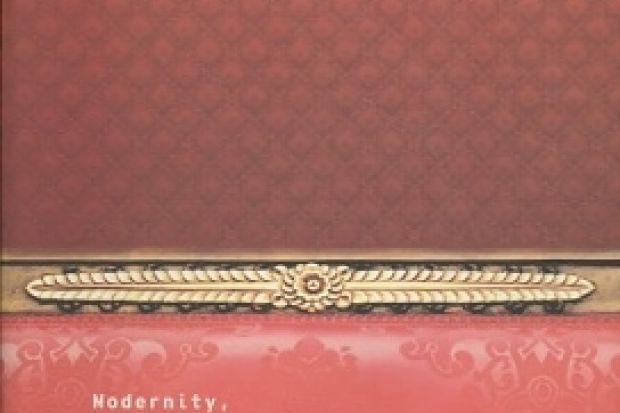I began Consuming Traditions: Modernity, Modernism and the Commodified Authentic with real enjoyment - for both its depth of scholarship and its detailed exploration of the contradictions of modernism, consumerism and modernity. I finished, though, a little frustrated that Outka is a literary critic rather than a social scientist, which is perhaps rather unfair of me.
The book is built on the argument that what Outka calls "the commodified authentic" is a modern bargain, a compromise bringing nostalgia into the radical commercialism of the Victorian (and indeed Edwardian) fin de siecle.
This compromise is found in the allegiances between commerce and authenticity, here represented by various figures of the rural, the idyllic, the nostalgic, the domestic. The "commodified authentic" refers to a range of aesthetic and commercial shifts which, in Outka's vision, stretches from the Utopian speculation of the new model towns of Bournville, Port Sunlight and Letchworth, the homes and gardens of Sir Edwin Lutyens and the Ideal Home Show, through the explosion of consumer abundance in Selfridge's, to the fabric of the transitional literature of almost-modernism and early modernism, such as George Bernard Shaw's Major Barbara, Henry James' The Great Good Place, H.G. Wells' Tono-Bungay and - of course - E.M. Forster's Howard's End.
In a concluding chapter, she also draws in a new argument: that the modernism proper of Virginia Woolf, James Joyce and D.H. Lawrence also embraces these notions of compromise between commerce and authenticity.
Outka's starting point is that many scholars are somewhat sniffy about commerce. Historically, scholarship itself has bought into the idea that "authenticity" and "trade" are opposed. But, as Outka makes clear, the nostalgic authentic and the thrillingly commercial are inextricably linked within both modernity and modernism. She quotes Shaw, who satirises this aesthetic purism via Barbara's mockery: "If I were middle class I should turn my back on my father's business; and we should both live in an artistic drawing room, with you reading the reviews in one corner, and I in the other at the piano, playing Schumann: both very superior persons, and neither of us a bit of use." I laughed out loud at Shaw's humour and cheered Outka on in her quest to make this democratic aesthetic real through a careful re-reading of commerce.
Where I find this book difficult is perhaps more the incommensurability of literary interpretation and social science. While I have no doubt that Outka's story is correct - there clearly was a movement in literature and in commerce that aesthetically and materially expressed the anxieties and traditions around the dramatic changes of the Victorian and Edwardian era - the explanatory devices she uses to make this case remain a bit vague. The analytical strategy seems to be "and here's another example of the commodified authentic", as if traversing from Howard's End to Lever's model village were all part of the same territory.
In one sense - and perhaps Raymond Williams' structure of feeling is that sense - they are part of the same territory. Outka's claim is that we need to interpret aesthetic processes with the same lens because we infer similar social anxieties, and economic pressures and political needs are brought to bear on these processes in any period.
But in another sense, there was something annoyingly repetitive about reading the same claim stretched through every chapter: that the allegedly authentic was placed against the more-or-less openly commercial, and that commercial interests (of which Selfridge's is the exemplar with its adoption - invention, even - of "lifestyle" shopping) tried very hard to cover this up. When Outka states that goods were presented "free from the alleged taint of commercialism" (that is, with no obvious process of exchange, and packaged as if from a museum or luxurious salon) and (in her weakest claim) that the work practices at Selfridge's were "just like small villages across England", the reader is left in need of a bit more analysis.
There is no discussion, for example, of the construction of discourses of authenticity, home and nostalgia; of the conditions of exchange that allowed Selfridge's such success; of the structures of taste and class that underpin many of Outka's concerns. In a few brief references to Pierre Bourdieu and his notion of cultural capital, she hints there is more to the "commodified authentic" than its representations in cultural forms. I wanted to read more of this.
This is a detailed, scholarly read, though, reservations notwithstanding. To a bookshelf including Raymond Williams' The Country and the City, Patrick Wright's On Living in an Old Country, Paul Oliver et al's Dunroamin and Rachel Bowlby's Just Looking, it is a fine addition.
Consuming Traditions: Modernity, Modernism, and the Commodified Authentic
By Elizabeth Outka
Oxford University Press
232pp
£25.99
ISBN 9780195372694
Published 4 December 2008
Register to continue
Why register?
- Registration is free and only takes a moment
- Once registered, you can read 3 articles a month
- Sign up for our newsletter
Subscribe
Or subscribe for unlimited access to:
- Unlimited access to news, views, insights & reviews
- Digital editions
- Digital access to THE’s university and college rankings analysis
Already registered or a current subscriber? Login
